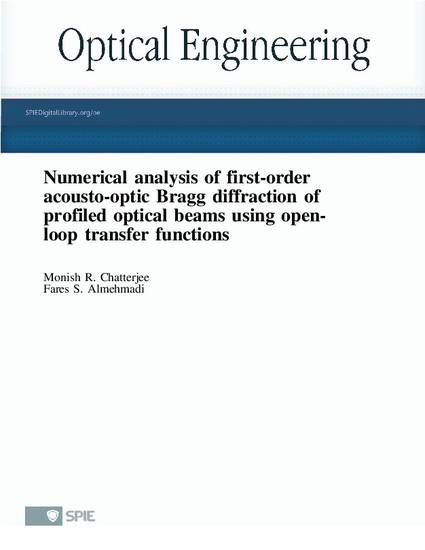
In standard acousto-optic Bragg analysis, the incident light and sound beams are assumed to be uniform plane waves (with constant profiles) leading to the results based on standard weak interaction theory. As a follow-up to earlier work dealing with nonuniform incident optical beams, we revisit the problem of Bragg diffraction under nonuniform profiles, and include Gaussian, third-order Hermite–Gaussian, and zeroth-order Bessel profiles in our investigation, along with a few others. The first-order diffracted beam is examined (using a transfer function formalism based on angular spectra) under several parametric limits [such as the Klein–Cook parameter Q, the effective profile width, and the optical phase-shift parameter (α^ 0) in the sound cell]. Wherever feasible, the numerical results are compared with analytic theory. The scattered first-order profile output versus the optical phase-shift appears to maintain behavior similar to the known first-order characteristics (sin2 in intensity) encountered for the uniform incident beam case.
It is observed, however, that such conformity exists seemingly only at relatively small values of Q (typically about 20 to 50). At higher Qs, on the other hand (where one would otherwise expect behavior closer to standard Bragg theory based on large Qs), it is found that the first-order intensity deviates substantially from the expected sin2- (or related) pattern. This deviation actually becomes more severe at even higher Qs.
Additionally, the output profiles at higher Qs are also found to be distorted relative to the incident profiles. These results, though anomalous, are nevertheless generally compatible with earlier studies. Based on the transfer function theory, it is also known that for very large optical phase shifts (i.e., when α^ 0 goes to infinity), the scattered first-order output for a Gaussian profile undergoes an axial (spatial) shift past the output plane of the sound cell.
This predicted result is corroborated in our numerical simulation for both the Gaussian and third-order Hermite–Gaussian profiles, but not the zeroth-order Bessel or Airy profiles. These results provide both confirmation of some expected behavior for profiled beam scattering (including likely affirmation of the well-known and unique diffractionless properties of certain Bessel beams), but also some insight into unexpected and anomalous photon-phonon interaction behavior.
Available at: http://works.bepress.com/monish_chatterjee/32/

This document is provided for download in compliance with the publisher's policy on self-archiving. Permission documentation is on file.
DOI: http://dx.doi.org/10.1117/1.OE.53.3.036108